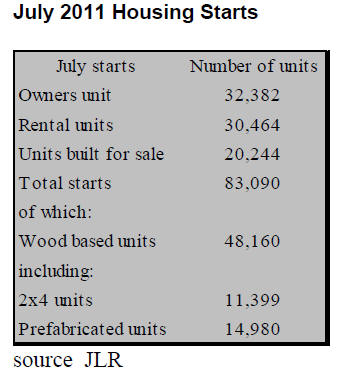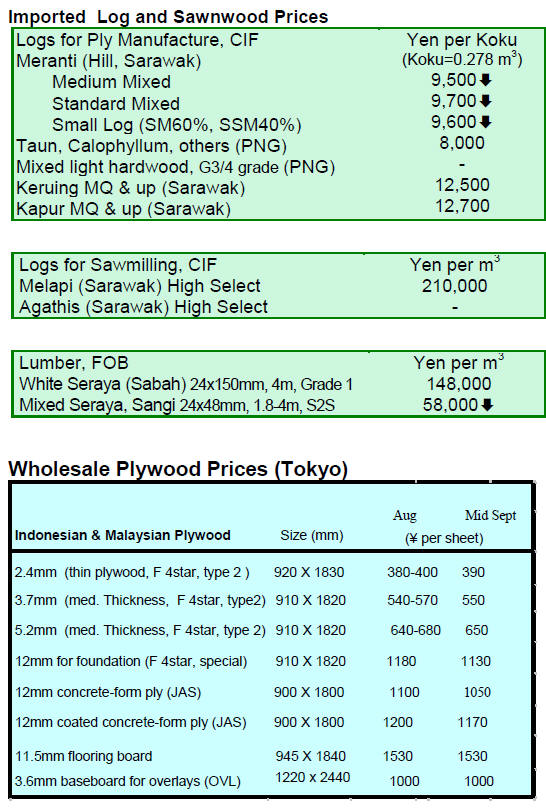Japan Wood Products
Prices
Dollar Exchange Rates of
15th September 2011
Japan Yen 77.22
Reports From Japan
July housing starts surge on last minute buying to
earn eco-points
July housing starts in Japan totalled 83,398 units, 21%
more than the same month last year reports the Japan
Lumber Reports (JLR).
On an annual basis housing starts would exceed 955,000
units, around 17% more than when using June data to
make annual projections. The level of annual housing
starts has not exceeded 900,000 units in two and a half
years.
Japan’s housing starts stagnated after the March East
Japan earthquake but then recovered as home buyers
rushed to take advantage of the government sponsored
housing eco point system, a government incentive plan for
house buyers which has now ended.
Despite this surge in starts the medium to long term
prospects for builders are bleak with most having low
levels of orders.
In the July starts, owner units stood at 32,382, the highest
in almost three years says the JLR. Units built for rent
totalled 30,464 units, the highest in two and a half years.
The largest overall increase was in condominium unit
starts which increased by 80% compared to July last year.

Sharp correction in Sarawak log prices but onset of
rains could signal a reversal
The JLR is reporting that Meranti FOB log prices in
Sarawak and wholesale prices in Japan are softening. In
Sarawak, Meranti log prices have dropped sharply
from levels in late August. Currently, Meranti regular log
quality prices are US$270-300 per cu.m FOB, US$30-40
down from July.
The trade is saying that, at the moment, prices are varying
depending on the supplier so it is difficult to be confident
about the average price.
Meranti small log prices are in the range of US$240-270
per cu.m and super small log prices are US$220-260 per
cu.m, generally around US$30 down from levels in July.
This rather sharp correction in price is not very surprising
as prices rose steeply in the first and second quarter of the
year and were due for a correction.
Prices for mixed Serayah logs from Sabah have been
dragged down by the drop in Sarawak log prices says the
JLR.
However, the drop in Sabah log prices is more moderate
than in Sarawak as they did not climb so steeply earlier in
the year.
In contrast, kapur and keruing log prices remain firm and
unchanged. Sabah Kapur prices are about US$380 per
cu.m FOB and Keruing prices are at US$350-360 per
cu.m.
In Malaysia, the weather influences harvesting so log
prices can vary depending on supply from the forest. The
JLR points out that no one can predict if the falling log
prices are here to stay or whether this is a short term
change. Much depends on log production levels and how
active are other log importing countries such as India and
China.
The rain season in Sarawak and Sabah begins in
November and log importers in Japan will be closely
watching log price movements from now until the onset of
the rains.
Tropical hardwood log wholesale prices experience a
sharp correction in Japan
The log market in Japan is weak according to the JLR.
Wholesale log prices in Japan during July were the highest
for many months due to rising FOB prices. In the space of
just a few weeks the market has witnessed a sharp
correction with prices easing due to lower FOB prices
and due to the stronger Yen.
Wholesale prices for regular quality Meranti logs
arriving in August were Yen 9,500 per koku CIF, Yen
300-400 per koku lower than in July. However, prices
for regular Kapur logs from Sabah are unchanged at Yen
11,500 per koku.
Increasing number of Japanese sawmills cutting
domestic species
Results from a survey by the Japan Forest Products
Journal show a marked change in the number of mills
processing domestic species.
Ten years ago a similar survey was conducted which
revealed that only four mills were cutting more than
50,000 cu.m of domestic species every year.
The recent survey shows that this has increased to 31
reports the JLR. In terms of volume, the top ten sawmills
using domestic species consumed 1,386,100 cu.m per year
compared to just 416,760 cu.m in 2001.
The biggest consumer of domestic species is Tohsen in
Tochigi Prefecture, north of Tokyo. This company has 22
mills with annual domestic log consumption of 280,000
cu.m in 2010 compared to 54,000 cu.m in 2001.
The second largest consumers of domestic logs are Kyowa
Mokuzai and Kawai Ringyo both of which consumed
180,000 cu.m in 2010.
The supply of kiln dried domestic species sawnwood has
been increasing. and the top ten millers produced around
32% of the total kiln dried sawnwood production in 2010.
The production of kiln dry sawnwood by the 31 mills
consuming more than 50,000 cu.m of domestic logs a year
was found to be 815,000 cu.m in 2010, 20 times more than
2001.
This volume of kiln dry sawnwood from domestic species
was around 32% of the total kiln dry sawnwood
production in 2010. As the JLR points out, higher
production of kiln dry sawnwood from domestic species
will encourage large house builders and pre-cutting plants
to use more domestic timber for housing.

Related News:
|